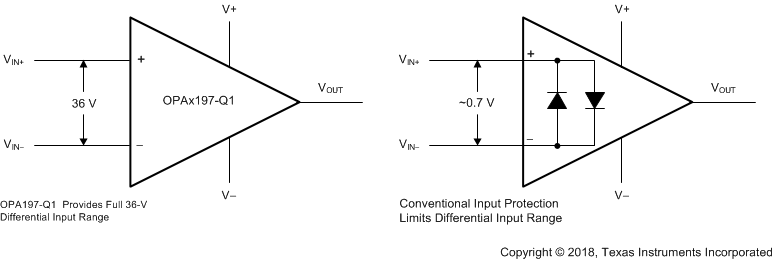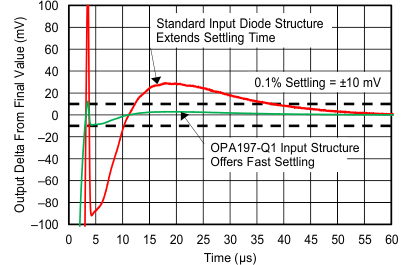ZHCSHU3A March 2018 – January 2021 OPA197-Q1 , OPA2197-Q1 , OPA4197-Q1
PRODUCTION DATA
- 1 特性
- 2 应用
- 3 说明
- 4 Revision History
- 5 Pin Configuration and Functions
-
6 Specifications
- 6.1 Absolute Maximum Ratings
- 6.2 ESD Ratings
- 6.3 Recommended Operating Conditions
- 6.4 Thermal Information: OPA197-Q1
- 6.5 Thermal Information: OPA2197-Q1
- 6.6 Thermal Information: OPA4197-Q1
- 6.7 Electrical Characteristics: VS = ±4 V to ±18 V (VS = 8 V to 36 V)
- 6.8 Electrical Characteristics: VS = ±2.25 V to ±4 V (VS = 4.5 V to 8 V)
- 6.9 Typical Characteristics
- 7 Detailed Description
- 8 Application and Implementation
- 9 Power Supply Recommendations
- 10Layout
- 11Device and Documentation Support
- 12Mechanical, Packaging, and Orderable Information
7.3.1 Input Protection Circuitry
The OPAx197-Q1 use a unique input architecture to eliminate the need for input protection diodes but still provide robust input protection under transient conditions. Conventional input diode protection schemes shown in Figure 7-1 can be activated by fast transient step responses, and can introduce signal distortion and settling-time delays because of alternate current paths, as shown in Figure 7-2. For low-gain circuits, these fast-ramping input signals forward-bias back-to-back diodes, causing an increase in input current, and resulting in extended settling time, as shown in Figure 7-3.
 Figure 7-1 OPAx197-Q1 Input Protection Does Not Limit Differential Input Capability
Figure 7-1 OPAx197-Q1 Input Protection Does Not Limit Differential Input Capability Figure 7-2 Back-to-Back Diodes Create Settling Issues
Figure 7-2 Back-to-Back Diodes Create Settling Issues Figure 7-3 OPAx197-Q1 Protection Circuit Maintains Fast-Settling Transient Response
Figure 7-3 OPAx197-Q1 Protection Circuit Maintains Fast-Settling Transient ResponseThe OPAx197-Q1 family of operational amplifiers provides a true high-impedance differential input capability for high-voltage applications. This patented input protection architecture does not introduce additional signal distortion or delayed settling time, making these devices the optimal op amps for multichannel, high-switched, input applications. The OPAx197-Q1 tolerate a maximum differential swing (voltage between inverting and noninverting pins of the op amp) of up to 36 V, making these devices an excellent choice for use as comparators or in applications with fast-ramping input signals, such as multiplexed data-acquisition systems; see Figure 8-1.